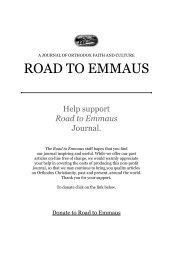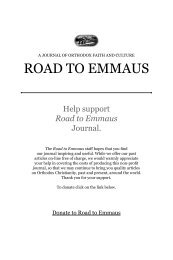RTE No 20 Interior - Road to Emmaus Journal
RTE No 20 Interior - Road to Emmaus Journal
RTE No 20 Interior - Road to Emmaus Journal
Create successful ePaper yourself
Turn your PDF publications into a flip-book with our unique Google optimized e-Paper software.
<strong>Road</strong> <strong>to</strong> <strong>Emmaus</strong> Vol. XII, <strong>No</strong>. 2 (#45)CROAGH PATRICK<strong>to</strong> the new government and the terms of the settlement with Britain, seizedcontrol of buildings in the centre of Dublin. The forces of the new Irish Government,Michael Collins and his men, shelled the national archives withincendiary shells and 90% of the country’s written records were lost. Thisis one of the great tragedies of Irish his<strong>to</strong>ry, because these records had surviveda thousand years of war. The loss is irreparable.<strong>RTE</strong>: How incredibly sad.MICHAEL: Yes. It probably isn’t until the 17th century again, that we have anaccount of Croagh Patrick being climbed on its traditional day, the last Sundayin July. Until <strong>to</strong>day, there is also another pilgrimage <strong>to</strong> the <strong>to</strong>p done onthe Friday before, by the people who live west of Croagh Patrick. It is calledCrom Dubh Friday. Crom Dubh (“black and bent”) was the pagan demonassociated with St. Patrick on Croagh Patrick. Local his<strong>to</strong>ry is full of thesebattles between Patrick and Crom Dubh: Patrick always wins, of course, andthe devil is drowned in the lake at the bot<strong>to</strong>m. The mountain is also regularlyclimbed on St. Patrick’s Day, but this is often very wintry weather, and therehave been many fatalities just from the cold. But there are always climbers,every day of the year.For the millennium year in <strong>20</strong>00 we wanted <strong>to</strong> have the night pilgrimageback, which was the original tradition. One wise-cracker said, “The reasonit was a night pilgrimage is obvious. If you’d seen the height of it during theday, you’d never go up.” (laughter)Although we’ve lost most of the earlier his<strong>to</strong>rical records, one of the bestdescriptions of climbing Croagh Patrick is by Asenath Nicholson in her 19thcenturyaccount, Ireland’s Welcome <strong>to</strong> the Stranger. She had met impoverishedIrish in the hovels of New York. She’s a sort of evangelical protestantbut not pushy—in fact, she’s not a very enthusiastic evangelist. She gives outthe odd tract here and there but she’s much more interested in these newneighbors that have turned up. They’re half-starved, they’re very quarrelsome,but they’ve a great sense of life and fun. This is the Irish. She finallymoves <strong>to</strong> Ireland <strong>to</strong> see where they’ve come from, and she walks throughoutIreland right before and during the famine, and gives some harrowing accounts.She writes from Clifden <strong>to</strong> Letterfrack and calls it the most impoverishedplace she’s seen <strong>to</strong> date in Ireland. She climbs the Diamond, and thenshe goes <strong>to</strong> Croagh Patrick and is negotiating for a girl guide <strong>to</strong> bring her upthe mountain. She was asked for six pennies, but in the end she climbs up onher own. The guides at the bot<strong>to</strong>m are horrified that she’s going up on herown, but she won’t pay. She climbs up through the cloud and the mist anddescribes sliding down the scree. She’s a wonderful writer.Another of the best accounts is by Patrick Kavanagh, one of our most famous<strong>20</strong>th-century Irish writers, who wrote in the 50’s. (This account is inHarry Hughes’ book). Also, T. H. White, who wrote The Once and FutureKing. White was in Ireland during the Second World War as a conscientiousobjec<strong>to</strong>r and wrote a fabulous book called The Gods<strong>to</strong>ne and the Blackymor.The gods<strong>to</strong>ne is a s<strong>to</strong>ne the Inishkea Islanders were said <strong>to</strong> worshipas an idol and which they certainly used <strong>to</strong> perform magic and cast curses,but it was almost certainly a medieval saint statuette. This is a wonderfulnovel about the whole northwest, and even though he’s Protestant, he makesa marvelous account of it. It’s often the outside observers who pick up ondetails that you don’t see. Because our own archives were destroyed, theseoblique views on the culture and the pilgrimage are hugely important.<strong>RTE</strong>: With the records destroyed, there is even less physical evidence fromthose early centuries, but what can you tell us about the Black Bell of St. Patrick,which I understand is associated with the Reek?MICHAEL: The bell was traditionally brought on the Croagh Patrick pilgrimageevery year by the Geraghty family; pilgrims could kiss it for a penny. It isnow in the National Museum in Dublin and is an early Christian hand-bellcalled the ‘Clog Dubh Phádraig’ (the Black Bell of St Patrick). It is also knownas ‘Bearnán Bhrighde’ (the gapped bell of Brigid) and the ‘Clog Geal’ (thebright bell). All of the early accounts mention it. It was used <strong>to</strong> swear on inlegal matters (it was believed that the devil would carry off the swearer if he<strong>to</strong>ld an untruth). In 1838 it was owned by Hugh Geraghty who <strong>to</strong>ld the antiquarianJohn O’Donovan that the bell was originally white but turned blackas a result of the constant pelting at demons by the saint.<strong>RTE</strong>: True enough in spirit, anyway. <strong>No</strong>w, <strong>to</strong> end, pilgrims obviously climbCroagh Patrick out of love for God and the saint, but for what other reasons dopeople climb? You’ve already mentioned fulfilling vows, such as the Travellerwoman who tried <strong>to</strong> climb it three successive times for her nephew’s health.MICHAEL: People climb it for all sorts of reasons. My brother climbed it becausehe’s a bomb disposal officer in the Irish army and he was going on a3839










